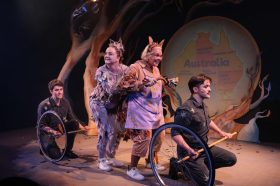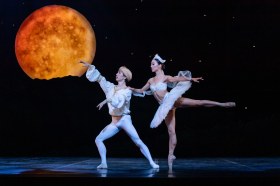We, advocates of the arts, have failed dismally to make our case about training. We’ve said it over and over, but was anyone listening? In the TAFE sector, especially under the new ‘Skills for All’ changes, we have been failing to make the case that art skills are in demand, and that tertiary institutions can supply that demand – and that therefore funding should be forthcoming for those places.
Now I say, failing, but certainly at the Adelaide College of the Arts (a part of TAFE SA) , under the inspired creative directorship of Christie Anthony, we are working hard to redress that failure. A presentation last week by the staff member who looks after Stage Management and some areas of Technical production says that there is a skills shortage in Stage Management in South Australia, a state which predicates a fair share of its economy on a lively festivals and events calendar. She also says that 100% of her graduates go into immediate employment in the industry.
This is a very healthy demand and supply ecology but not widely understood – and clearly not by those students inclined to enroll. In the initial enrollments for 2013 courses, there are 12 enrollments for 12 places in Stage Management (that’s good), but there are 90+ applications for 20 places in drama.
…
Recent changes in VET/TAFE, the growth of private-sector suppliers and the universities heading helter-skelter for the more lucrative post-grad research sphere, demand questions about the importance of a degree.
I think it’s obvious that whether a degree ends up making an actual difference to your future or not, young people, undertaking tertiary education, and their parents, think it’s important, and many of those who don’t get the scores they need for university, and don’t have a realistic understanding of what an apprenticeship can do for you, probably feel disappointed that they might have to start considering a vocational training path instead.
We can’t deny that brand and prestige are absolutely core to student choice. You don’t need to persuade aspiring heavy machinery handlers or electricians, or hospitality workers, hairdressers or graphic designers, of the value of TAFE certificates. They are the accepted industry norm. But there’s a world of persuasion to be utilised to those who seek careers for which there are university and degree alternatives.
One of the main barriers, in both areas of need (that is, the need of arts students to value the kind of arts training TAFE can offer, and the equally strong need for TAFE to understand where the arts fit in their master/apprentice hands-on model) is the lack of understanding of where the arts fit in any civil society, and particularly in Australia.
So, arguments about the value of the arts not only apply to a general public, but clearly now specifically and urgently to the many and varied bodies which are determining the shape of tertiary education to come.
Many aspiring young artists are still delusional about the arts as something almost wholly spiritual and to do with gifts and talent. They are in denial or ignorance of the massive amount of skills acquisition it takes – physical, mental, financial, time-managerial, mechanical, technical. It’s the same kind of skills acquisition which equates with almost any other trade.
And many in the world of vocational training still don’t grasp a good understanding of those skills either – so similar to skills in other traditional TAFE offerings – and therefore also don’t see where the arts fit in terms of jobs.
The $30 billion economic contribution the arts make to productivity and employment is not to be sneezed at, yet this contribution is little understood anywhere in the nation. The arts create jobs, there are escalating demands for skills in the arts, entertainment and creative industries.
Yet the TV commercial I saw in Adelaide to promote the new Skills for All regime, consisted only of the imagery of mining – the big beautiful trucks they teach young folk to drive as part of skills acquisition that might place them well for careers in that industry. Yes, those futures are massive in South Australia – but they are not the only ones. Especially in Adelaide, with an economy designed to flourish through a multitude of festivals, we need skilled labour in the arts to work in those festivals, and in the number of arts companies now based here, but touring the nation and the world. Why do those ads not include the trades needed to be a theatre electrician or lighting designer, or set builder for Olympic and Commonwealth games openings?
…
TAFE courses offer more contact hours than similar university-based courses. This is what arts training demands: there are only so many students you can fit round a sound or lighting box in order to make them proficient in the handling of that machinery. The education of jewellers or ceramicists or violinists is even more demanding of one-to-one teaching. Dance classes cannot be infinitely expandable, nor can voice or piano classes. TAFE training is about doing, making, getting your hands on and getting them dirty, in small classes, and one to one instruction. So the fact is that many who want to undertake training in the arts are probably better off in a TAFE-like system. So why isn’t it happening?
I think it’s mainly a matter of perception and status, and the genesis is not in the system, but in our societies. If the issue of training, careers and jobs in the arts is to be taken seriously anywhere, the presence of the arts must be acknowledged and valued.
The people we live amongst need to disabuse themselves of the delusion that, outside their economic value, the arts are somehow expendable as a luxury. It is this simple – our lives are enriched every day by what artists do. No-one escapes that benefit, you couldn’t if you tried as the installation would demonstrate. If that is the fact, then we need artists, our societies need artists and artists need training. It is exactly the same argument for fitters, turners, welders, heavy machinery operators, hairdressers.
So the sphere of vocational training itself needs to acknowledge that it can be a natural home for arts training to supply the ever-increasing demand for jobs in arts and entertainment.
This article is an edited extract of a speech delivered for Currency House on 28 November, 2012.





